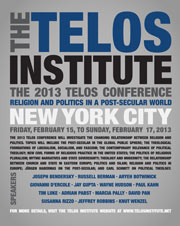The following paper was presented at the Seventh Annual Telos Conference, held on February 15–17, 2013, in New York City.
 Province of Québec’s territory is vast, and much of it has been left in what could be considered a “natural” state. Today’s paper will focus on one particular region called Abitibi-Témiscamingue, located on the west side of the province, but north of Montreal (which is why we usually refer to it as a northern area).
Province of Québec’s territory is vast, and much of it has been left in what could be considered a “natural” state. Today’s paper will focus on one particular region called Abitibi-Témiscamingue, located on the west side of the province, but north of Montreal (which is why we usually refer to it as a northern area).
Abitibi-Témiscamingue has been occupied for more than 8000 years, with the latest occupants being the Algonquins (the Abitibi and the Témiscamingue being the two main groups of Natives living there when Europeans arrived). While their presence has been known since the first French merchants came in the 1700s to trade fur, it is only around 1837–38 that Montreal’s Bishop decided to “take care” of these poor souls and sent missionaries to convert them. In 1863, the Oblate missionaries founded a permanent mission and from there, travelled the entire territory.


